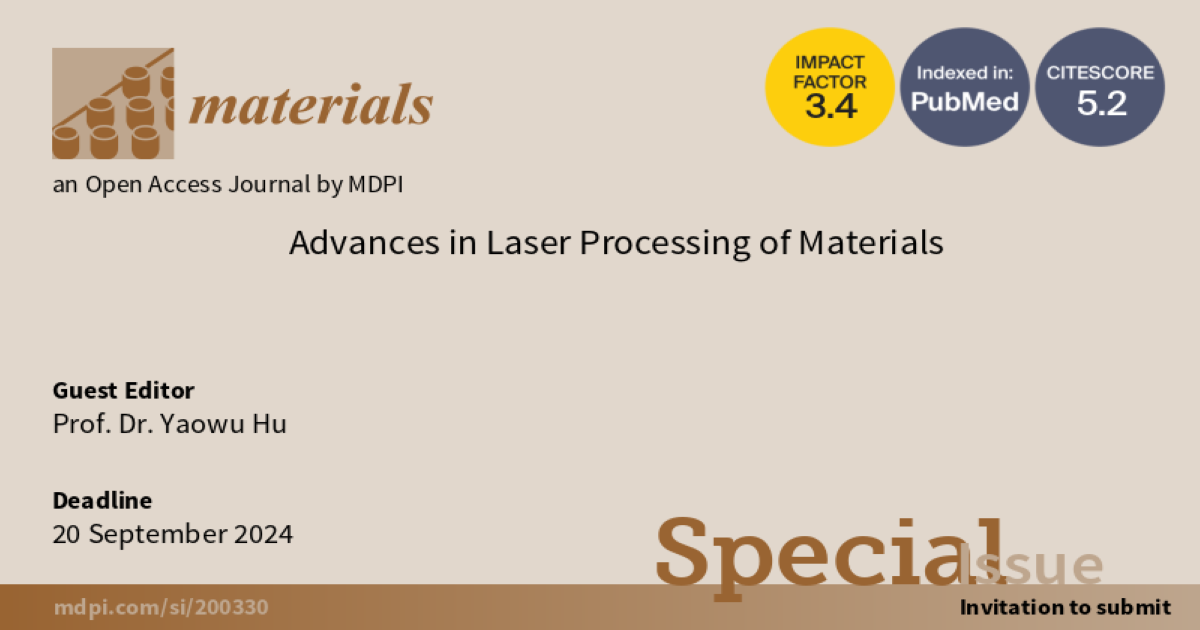Advances in Laser Processing of Materials
A special issue of Materials (ISSN 1996-1944). This special issue belongs to the section "Manufacturing Processes and Systems".
Deadline for manuscript submissions: closed (20 September 2024) | Viewed by 2781

Special Issue Editor
Interests: laser advanced manufacturing
Special Issues, Collections and Topics in MDPI journals
Special Issue Information
Dear Colleagues,
As a new set of material processing tools, Lasers have been attracting intense research interest in terms of their potential for additive, subtractive, and formative manufacturing systems. Researchers across various disciplines are achieving rapid progress in areas such as ultrafast or precise laser machining, advanced laser 3D printing methods, the physics underlying novel laser shock processing, emerging laser induction of 2D materials and the hybrids, new laser sources, cutting-edge laser annealing, and welding approaches and applications. Furthermore, artificial intelligence is becoming highly integrated with advanced manufacturing. This Special Issue aims, therefore, at connecting multidisciplinary academic scholars including physicists, chemists, optical/mechanical/materials engineers, and data scientists, as well as industry stakeholders and government officials, for the advancement and application of laser processing of materials. Modeling, experimental, numerical, and design works are all welcome submissions.
Prof. Dr. Yaowu Hu
Guest Editor
Manuscript Submission Information
Manuscripts should be submitted online at www.mdpi.com by registering and logging in to this website. Once you are registered, click here to go to the submission form. Manuscripts can be submitted until the deadline. All submissions that pass pre-check are peer-reviewed. Accepted papers will be published continuously in the journal (as soon as accepted) and will be listed together on the special issue website. Research articles, review articles as well as short communications are invited. For planned papers, a title and short abstract (about 250 words) can be sent to the Editorial Office for assessment.
Submitted manuscripts should not have been published previously, nor be under consideration for publication elsewhere (except conference proceedings papers). All manuscripts are thoroughly refereed through a single-blind peer-review process. A guide for authors and other relevant information for submission of manuscripts is available on the Instructions for Authors page. Materials is an international peer-reviewed open access semimonthly journal published by MDPI.
Please visit the Instructions for Authors page before submitting a manuscript. The Article Processing Charge (APC) for publication in this open access journal is 2600 CHF (Swiss Francs). Submitted papers should be well formatted and use good English. Authors may use MDPI's English editing service prior to publication or during author revisions.
Keywords
- laser processing
- advanced manufacturing
- additive
- subtractive
- deformation
Benefits of Publishing in a Special Issue
- Ease of navigation: Grouping papers by topic helps scholars navigate broad scope journals more efficiently.
- Greater discoverability: Special Issues support the reach and impact of scientific research. Articles in Special Issues are more discoverable and cited more frequently.
- Expansion of research network: Special Issues facilitate connections among authors, fostering scientific collaborations.
- External promotion: Articles in Special Issues are often promoted through the journal's social media, increasing their visibility.
- Reprint: MDPI Books provides the opportunity to republish successful Special Issues in book format, both online and in print.
Further information on MDPI's Special Issue policies can be found here.






